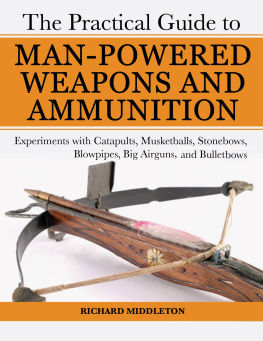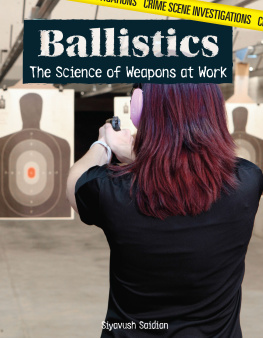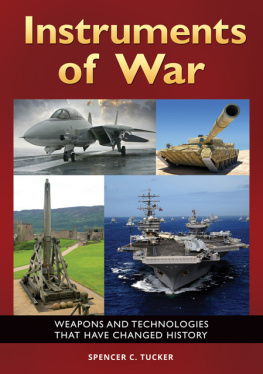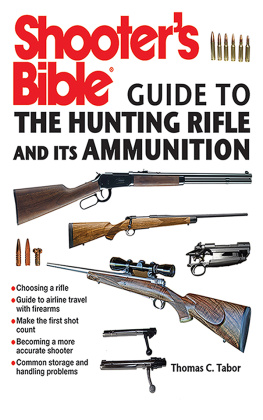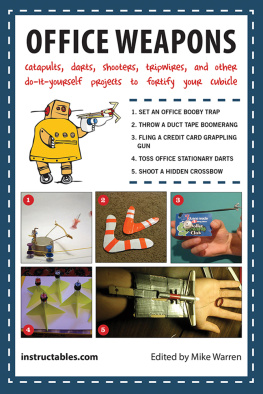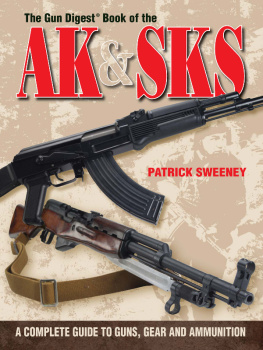Chapter 1 Ammunition
Helical flight of tracer bullets can be seen in plate 24 First Flight , 2002, by Geoffrey Wellum. The subject of lateral drift of spherical and elongated projectiles was gone into in great and fascinating detail by T. F. Fremantle in chapter 12 of The Book of the Rifle , 1901. That a round ball fired from a smooth-bore barrel will hit a man-sized target up to about 40 yards and up to 100 yards if from a long smooth barrel and a tight fit is given by Howard Blackmore in Hunting Weapons 1970, p. 276. Martin Pegler, Powder and Ball Small Arms , 1998, pp. 55-6, tested a Brown Bess and found it gave a 9-inch group with two flyers at 50 yards, a 31-inch group at 100 yards, and no bullet found the target at 200 yards. Robert Bailey describes poisoned arrows among the Efe of Zaire in National Geographic , vol. 176 no. 5, November 1989, pp. 664-686. Arthur Credland, Journal of the Society of Archer Antiquaries (JSAA), vol. 18, 1975, pp. 13-21 describes the use of clay balls in India for stonebows. Adrian Eliot Hodgkin, The Archers Craft , 1951, starts his chapter on the subject with the outrageous sentence Making a bowstring is a jolly business. I cannot bring myself to admit that so frustrating do I find string-making that once, to my infinite regret, I flung my copy a signed first edition across the room and damaged the cover. The velocity and mass of a golf ball can be found in Encyclopdia Britannica under Golf. Nelsons accuracy is given by H. A. Baker on p. 274, Journal of the Arms and Armour Society (JAAS), June 1985. Michael Glover, Warfare from Waterloo to Mons , 1980, p. 56, notes that Nelsons warships were touching one another when the guns were fired. Prof. Sir O. G. Sutton, p. 68, Mathematics in Action, 1966, quotes Nelson: that our shots cannot miss the object. Howard Blackmore, British Military Firearms , 1961 (revised ed. 1994) p. 274, gives the respective bore and diameter of ball of the Brown Bess musket and on p. 240 the rate of fire. Glover, ibid., p. 25 gives the rate of fire of a muzzle-loading rifle.
Chapter 2 The fibre-glass bullet-shooting crossbow
The Revd. W. B. Daniels ( Rural Sports , 1801-2), Sir Ralph Payne-Gallwey ( The Crossbow , 1903), Daniel Higson ( The Bullet Crossbow , 1922-3) Arthur Graves Credland (JSAA, vol. 15 pp. 22-36 and vol. 28, pp. 24-33) and A. Littler (JSAA vol. 34 1991 pp. 30-41) have all written extensively about the English bullet-shooting crossbow. The nineteenth-century reports of a bullet crossbow being able to hit a playing card at 50 yards and kill a dozen pigeons consecutively at 30 yards or more in Sporting Magazine , May 1859, p. 327 is quoted by A. G. Credland, JSAA vol. 15, 1972, p. 34. Page 35 gives the reference to G. Millard shooting six bullets into a two-inch circle at 50 feet, in Archery World , vol. 15, Feb 1966. George Agar Hansard, The Book of Archery , 1840, p. 238-9 describes the gambler allowing a glass to be shot off his head at 16 paces. G. W. Spearing, The Craft of the Gunsmith , 1986, p. 31 describes the tempering of a shotgun lock spring using mutton-fat in a country gun-makers to gauge the correct temper for the spring-steel. A photograph of a leg transfixed by a crossbow bolt is to be found in the British Medical Journal , BMJ 1990:301:70 (7 July). Chinese pellet shooting crossbows are illustrated in Josef Alms book European Crossbows: a Survey , English version 1994, p. 93. Lt. Cdr. W. Paterson describes coxcombing in A Guide to the Crossbow , p. 117. Tim Baker wrote a brilliant chapter on strings in Vol. 2 of The Traditional Bowyers Bible . J. E. Gordon on strength of string is on p. 90 of Structures , 1978.
Chapter 3 Yew-wood bullet crossbow
The discovery that a bow length of 66-67 inches is the fastest is given by Tim Baker, p. 69-70 of Vol. 1 of The Traditional Bowyers Bible , 1992. Otzis bow is described in The Man In The Ice ,1994, Konrad Spindler, p. 87 and his height on p. 160. The Statute of Edward IV in 1465 ordaining that everyone between 16 and 60 should have a bow of his own height plus a fistmele between the nocks is given by Lt. Cdr. W. F. Paterson, JSAA, vol. 24, 1981, p. 5. That doubling the thickness of a bow makes it eight times as stiff but it will recoil only twice as fast is given by Dr. Robert P. Elmer, Target Archery 1952, pp. 157 & 162. That the stress cannot be calculated directly as a function of the length of a bow is given by Paul E. Klopsteg, Turkish Archery 1934, 3rd edition 1987, p. 197. Blackmores reference to the slingers of Benjamins army (Judges, 20.16) is given in Hunting Weapons , p. 329. Klopsteg, Hickman and Naglers finding that one-third the string weight may be considered as arrow weight is in Archery, the Technical Side , 1947, p. 208 and that the velocity is inversely related to the cube root of the arrow weight, on p. 167. The Norwegian whaling crossbow is illustrated by Josef Alm, ibid., pp. 8-10, and A. G. Credland, JSAA Vol 26 1983, p. 13. Paul Comstock on leaving a bow strung for a while before shooting it is found in The Traditional Bowyers Bible , Vol. 2, p. 111. Ancient crossbow nuts of the crown of deer antler are described by A. G. Credland, JSAA, vol. 23, 1980, pp. 12-19.
Chapter 4 Catapults
Richard Jefferies reference to the squire is on p. 296, Field & Hedgerow , 1892, An English Deer Park . Hodges rubber-powered weapons are described by Raymond G. Rieser, JSAA, vol 31, pp. 13-19; and by Blackmore, Hunting Weapons , pp. 171, 209. Emmanuel E. Papagrigorakis description of a speargun is in The Underwater Man, A complete diving manual , 1980, tr. Philip Ramp. The Special Operations Executive rubber-powered crossbows are described by Arthur G. Credland, JSAA, vol 27, pp. 5-20. John Holden, Shooting Straight , 1987, p. 76 describes six archers who achieved velocities ranging from 159 fps to 194 fps using the same bow and the same arrow. J. E. Gordons reference to Griffith on crack propagation is from p. 99, and that rubber breaks in a brittle manner is on p. 103, ibid. On p. 306 he goes into the end fixings of tension members. A brief reference to the Shanghai in an article by Lee Warner on hunting in East Timor is on pp. 58-63, Guns & Game magazine, Number 40, Oct-Dec 2003.
Chapter 5 The hand stonebow
Long arrows are illustrated in countless articles in National Geographic magazine on South American and Papua New Guinea tribesmen, and in the whole of E. G. Heath and Vilma Chiaras book Brazilian Indian Archery 1977. Sir Anthony Aguecheeks stonebow is in Shakespeares Twelfth Night : Act II, Sc. V. That the inside of a tree is under compression is shown by J. E. Gordon on p. 281, ibid.. Propeller-twist is described on pp. 285-6, The Traditional Bowyers Bible , volume 1. The dial bendmeter is illustrated opposite p. 72, Elmer, ibid. The motion of a hand-held stonebow is described by A. G. Credland in probably the best study of this weapon, in JSAA, vol 18, 1975, pp. 13-21. Edward Morse described five different bow release holds in 1885; they are illustrated on p. 76 of Heath and Chiaras Brazilian Indian Archery .

